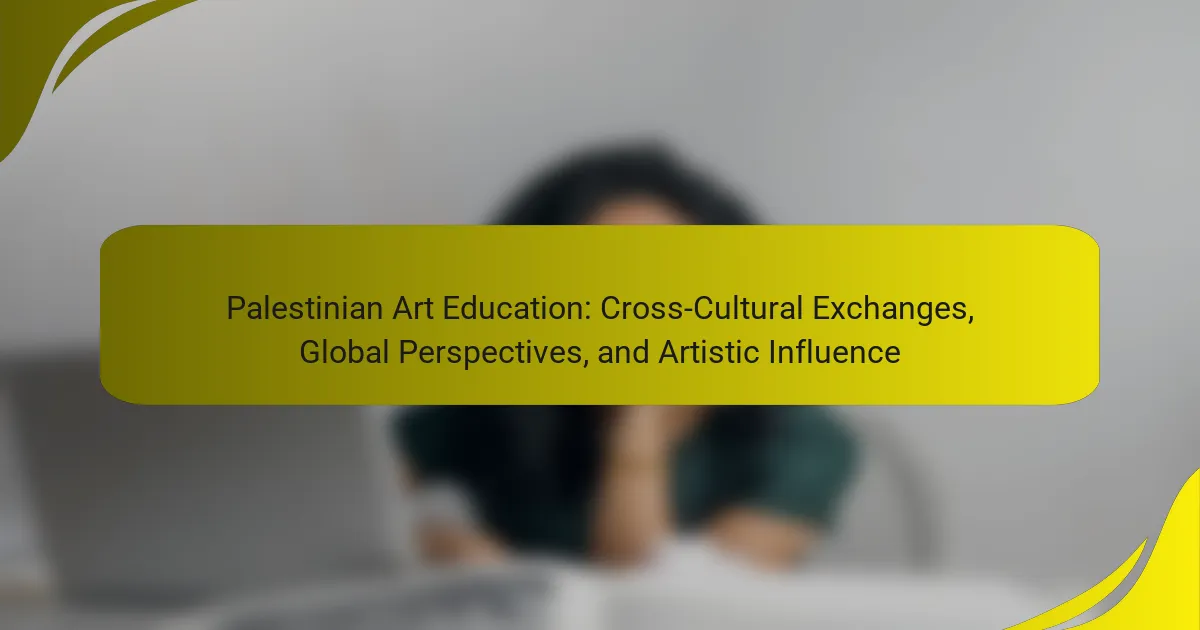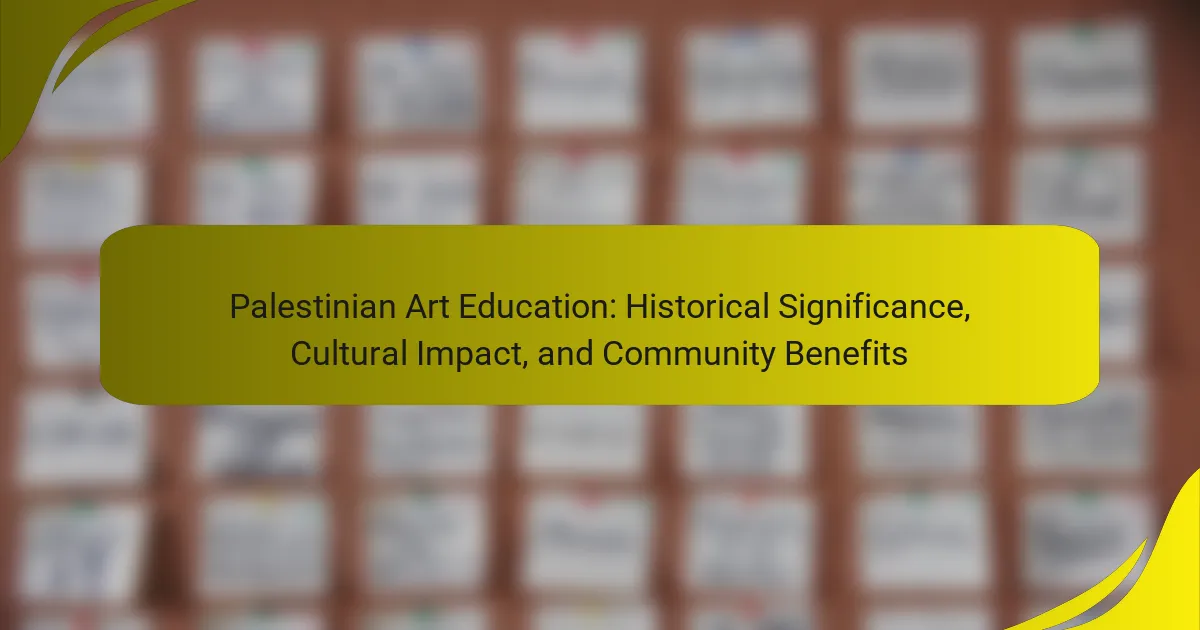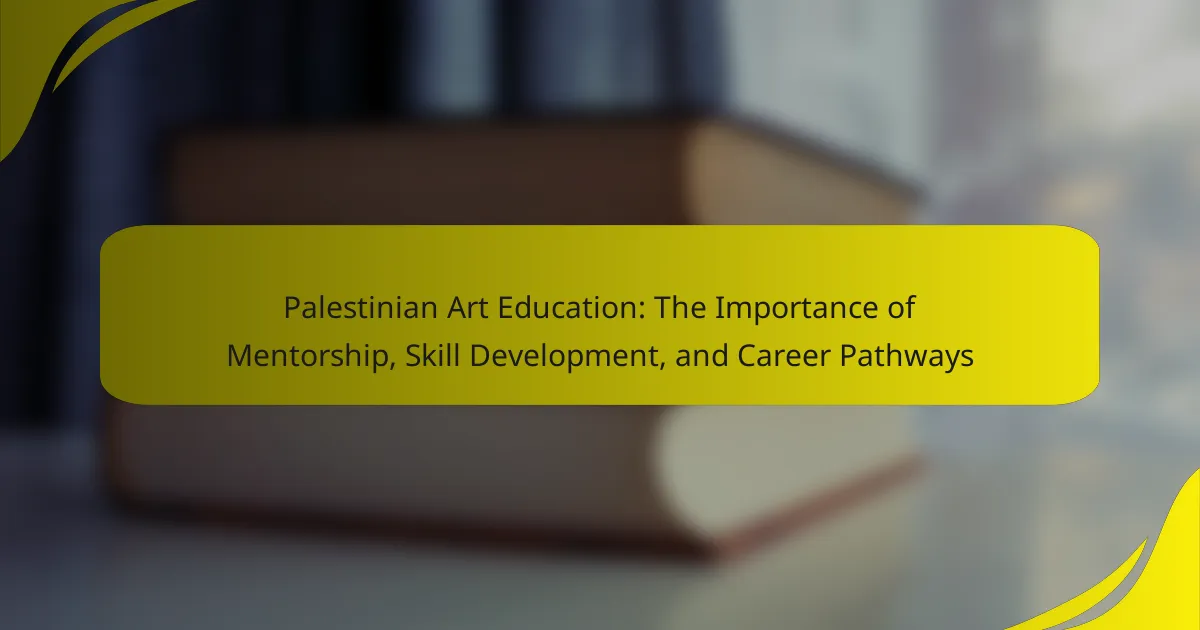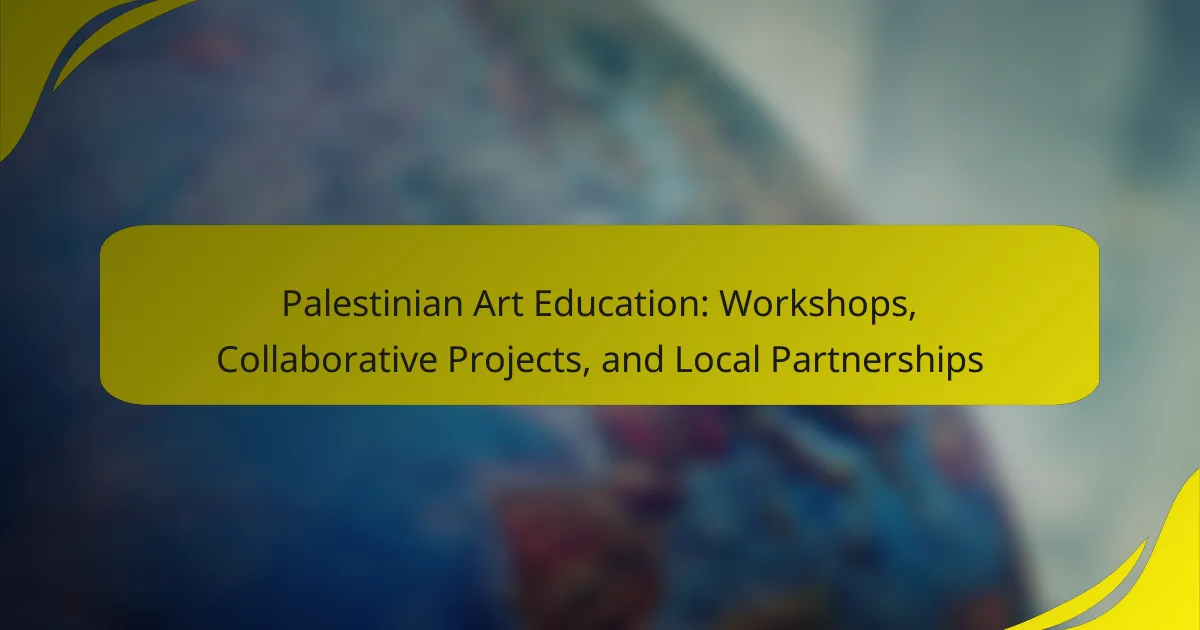Palestinian Art Education encompasses the teaching and learning of various artistic forms, including visual arts, music, and performance, within the Palestinian context. It emphasizes creativity, cultural identity, and critical thinking, supported by institutions such as the University of the Arts in Palestine and community art programs. This educational framework reflects the socio-political realities of the region, integrating themes of resistance and identity, while promoting cultural heritage and social change. The article explores influential Palestinian artists, their techniques, and their contributions to art education, highlighting the significance of these elements in fostering artistic engagement and cultural expression.
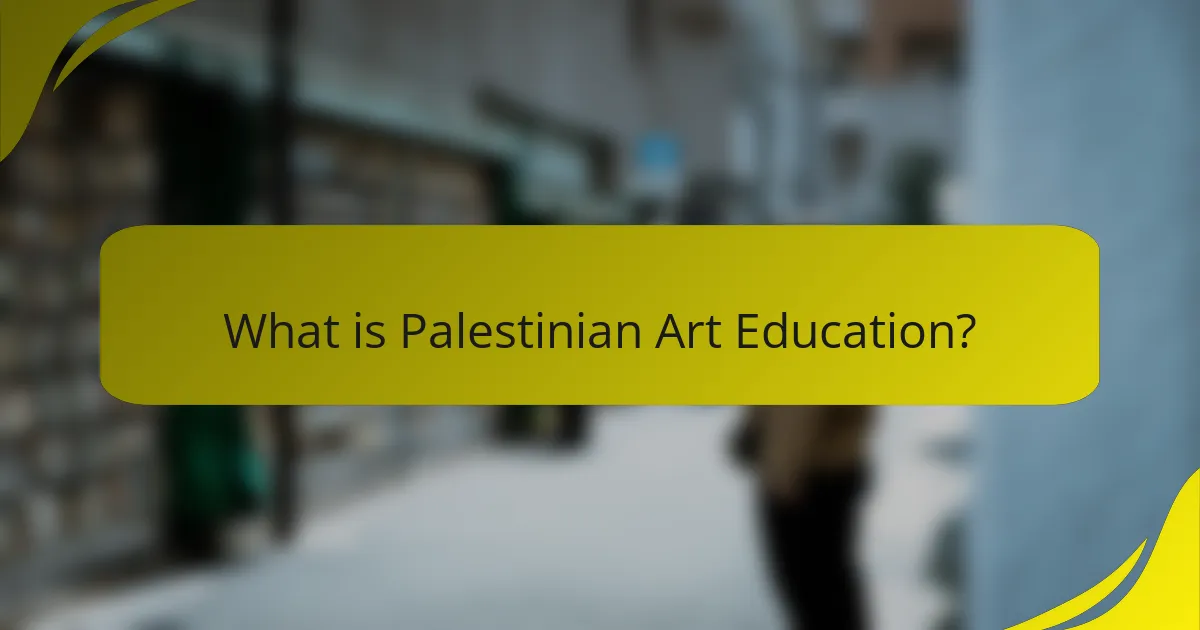
What is Palestinian Art Education?
Palestinian Art Education refers to the teaching and learning of art within the Palestinian context. It encompasses various forms of artistic expression, including visual arts, music, and performance. This education aims to foster creativity, cultural identity, and critical thinking among students. Institutions like the University of the Arts in Palestine play a significant role in this educational landscape. Additionally, community art programs often provide accessible platforms for artistic engagement. Palestinian Art Education also reflects the socio-political realities of the region, integrating themes of resistance and identity. This educational approach has gained recognition for its role in promoting cultural heritage and social change.
How has Palestinian Art Education evolved over time?
Palestinian Art Education has evolved significantly over the last century. Initially, it was informal and rooted in traditional practices. In the early 20th century, formal institutions began to emerge, influenced by Western art movements. The establishment of the Bezalel Academy in Jerusalem in 1906 marked a pivotal moment. This institution aimed to blend local traditions with modern techniques.
Post-1948, education faced challenges due to political upheaval. However, the establishment of the Palestinian Authority in the 1990s led to renewed focus on arts education. Contemporary programs now emphasize both cultural identity and technical skills.
Today, Palestinian art education incorporates various mediums and styles, reflecting global trends. Institutions like the International Academy of Art Palestine promote artistic expression and critical thinking. The evolution highlights resilience and adaptation in the face of adversity.
What historical events have influenced Palestinian Art Education?
The historical events that have influenced Palestinian Art Education include the Nakba in 1948, the Six-Day War in 1967, and the Oslo Accords in the 1990s. The Nakba led to the displacement of many Palestinians, affecting cultural expression and art education. Following this, the Six-Day War resulted in the occupation of Palestinian territories, which further shaped artistic themes around resistance and identity. The Oslo Accords introduced new educational frameworks and opportunities for Palestinian art institutions. These events collectively shaped the curriculum, themes, and methodologies in Palestinian art education, emphasizing cultural resilience and social commentary.
What role do cultural identity and heritage play in Palestinian Art Education?
Cultural identity and heritage are central to Palestinian Art Education. They shape the themes and techniques used by artists. This education emphasizes the importance of expressing national identity through art. Students learn to incorporate traditional motifs and stories into their work. This practice fosters a sense of belonging and continuity. Heritage influences the choice of materials and methods in artistic expression. For instance, the use of local resources highlights cultural ties. Additionally, art becomes a means of resistance and storytelling for the Palestinian people. This connection to identity enriches the educational experience and promotes cultural preservation.
Who are the influential artists in Palestinian Art Education?
Influential artists in Palestinian Art Education include Kamal Boullata, Ismail Shammout, and Mona Hatoum. Kamal Boullata is known for his contributions to contemporary Palestinian art and his focus on identity and memory. Ismail Shammout was a prominent painter whose works reflect the Palestinian experience and heritage. Mona Hatoum is recognized for her installation art that addresses themes of displacement and exile, influencing art education through her innovative approaches. These artists have shaped the curriculum and discourse within Palestinian art education, fostering a deeper understanding of cultural identity.
What are the notable contributions of these artists to Palestinian Art Education?
These artists have significantly advanced Palestinian Art Education through various initiatives. They have established art programs that foster creativity among students. They emphasize the importance of cultural identity in their teachings. Workshops led by these artists provide hands-on experience in different artistic techniques. They also contribute to curriculum development, integrating contemporary art practices with traditional methods. Their exhibitions serve as educational platforms, showcasing student work and promoting local talent. Collaborations with educational institutions enhance access to art education in marginalized communities. Their advocacy for art as a tool for social change inspires a new generation of artists.
How do these artists reflect the Palestinian experience through their work?
Artists reflect the Palestinian experience through their work by portraying themes of identity, resistance, and loss. They often use symbolism to express cultural heritage and historical narratives. Many artworks depict scenes of displacement and longing for home. These themes resonate with the collective memory of the Palestinian people. Artists utilize various mediums, including painting, sculpture, and photography, to convey their messages. For instance, the use of traditional motifs connects contemporary issues to historical contexts. The emotional depth in their work often evokes empathy and awareness among viewers. This artistic expression serves as a form of resistance against oppression and a means to preserve cultural identity. Through exhibitions and public installations, these artists engage audiences in conversations about the Palestinian experience.
What techniques are commonly used in Palestinian Art?
Palestinian art employs techniques such as embroidery, painting, and calligraphy. Embroidery, particularly traditional tatreez, showcases intricate patterns and cultural narratives. Painting often reflects social and political themes, using vibrant colors and symbolism. Calligraphy is used to express poetry and religious texts, often integrated into visual art. Additionally, artists may use mixed media, combining photography and traditional methods. These techniques convey the rich cultural heritage and contemporary issues faced by Palestinians. The techniques are a vital part of the artistic expression in Palestinian society.
How do traditional techniques differ from contemporary methods in Palestinian Art?
Traditional techniques in Palestinian art emphasize handcrafting and cultural symbolism, while contemporary methods often incorporate modern materials and themes. Traditional artists typically use natural pigments and materials, such as clay and wood, reflecting historical practices. In contrast, contemporary artists may utilize digital media and mixed techniques, allowing for broader expression. Traditional art often focuses on storytelling and heritage, while contemporary art can address social, political, and global issues. Historical context shows that traditional Palestinian art has roots in Islamic and Byzantine influences. Contemporary Palestinian art, however, is shaped by globalization and modern artistic movements, reflecting a fusion of local and international styles. This evolution illustrates a shift from preserving cultural identity to exploring contemporary narratives.
What are the unique characteristics of Palestinian artistic techniques?
Palestinian artistic techniques are characterized by a blend of traditional and contemporary methods. These techniques often incorporate vibrant colors and intricate patterns. Calligraphy plays a significant role, reflecting cultural heritage. Artists frequently use mixed media, combining painting, textiles, and ceramics. The themes often explore identity, resistance, and social issues. Many works are influenced by historical events and cultural narratives. The use of natural materials is common, connecting art to the landscape. Artists aim to convey emotion and storytelling through their creations.
What educational contributions have emerged from Palestinian artists?
Palestinian artists have made significant educational contributions through their artworks and community engagement. They utilize art as a means of cultural expression and storytelling. This approach fosters awareness of Palestinian history and identity. Artists often conduct workshops and educational programs aimed at youth. These initiatives promote artistic skills and cultural pride. Collaborative projects between artists and educational institutions enhance learning experiences. They also address social issues through art, encouraging critical thinking. Furthermore, exhibitions and public art installations serve as educational platforms. These contributions enrich the understanding of Palestinian culture and heritage.
How do artists engage with educational institutions to promote art education?
Artists engage with educational institutions to promote art education through workshops, exhibitions, and collaborative projects. These activities allow artists to share their techniques and insights with students. Workshops often focus on specific skills or mediums, enhancing students’ practical abilities. Exhibitions provide a platform for students to showcase their work alongside established artists. Collaborative projects foster a sense of community and encourage creative expression. Research indicates that such engagements can significantly improve students’ understanding of art and its cultural relevance. For example, the “Art in Education” initiative has successfully integrated local artists into school curricula, enriching the educational experience.
What initiatives have been established to support art education in Palestine?
Initiatives to support art education in Palestine include programs by local organizations and international partnerships. The Al-Quds University has established an art department that offers degrees in fine arts. The Palestinian Museum provides workshops and exhibitions to foster artistic skills. Additionally, the “Art for All” initiative promotes accessibility to art education in underserved communities. The “Palestine Youth Empowerment Program” integrates art into youth development. These initiatives aim to cultivate creativity and preserve cultural heritage. They address the need for artistic expression in a challenging socio-political context.
How can one support Palestinian Art Education today?
One can support Palestinian Art Education today by donating to organizations that focus on art programs in Palestinian communities. These organizations often provide resources, materials, and training for aspiring artists. Supporting local art initiatives helps foster creativity and cultural expression. Participating in fundraising events or workshops can also raise awareness and funds for these programs. Additionally, promoting Palestinian artists and their work through social media can increase visibility and appreciation. Collaborating with Palestinian artists on projects can create opportunities for cultural exchange. Lastly, advocating for policies that support educational access in Palestine can help sustain art education in the region.
What resources are available for those interested in learning about Palestinian Art?
Books on Palestinian art include “Palestinian Art: A Contemporary History” by Anneka Lenssen. Online platforms like the Palestinian Museum offer virtual exhibitions and educational resources. Documentaries such as “The Art of Resistance” explore the cultural significance of Palestinian art. Workshops and courses are available through organizations like Al-Quds University. Art galleries in Palestine, such as the Khalil Sakakini Cultural Center, provide exhibitions and educational programs. Social media channels and websites of Palestinian artists also serve as valuable resources. These resources collectively enhance understanding and appreciation of Palestinian art.
How can individuals contribute to the growth of Palestinian Art Education?
Individuals can contribute to the growth of Palestinian Art Education by supporting local artists and institutions. They can donate to art programs that focus on Palestinian culture. Engaging in workshops can help spread knowledge and techniques. Volunteering time at art schools enhances educational opportunities. Purchasing artwork directly from Palestinian artists provides them with financial support. Promoting Palestinian art through social media raises awareness and appreciation. Attending exhibitions showcases the talent of local artists. Collaborating with educational institutions can lead to more comprehensive art curricula.
Palestinian Art Education encompasses the teaching and learning of various artistic expressions within the Palestinian context, focusing on creativity, cultural identity, and critical thinking. The evolution of this education has been shaped by historical events, influential artists, and the integration of traditional and contemporary techniques. Key contributors, such as Kamal Boullata and Mona Hatoum, have significantly impacted the curriculum and discourse, promoting cultural heritage and social change. Initiatives supporting art education in Palestine aim to enhance accessibility and foster artistic skills among youth, while resources for further exploration of Palestinian art are readily available.
